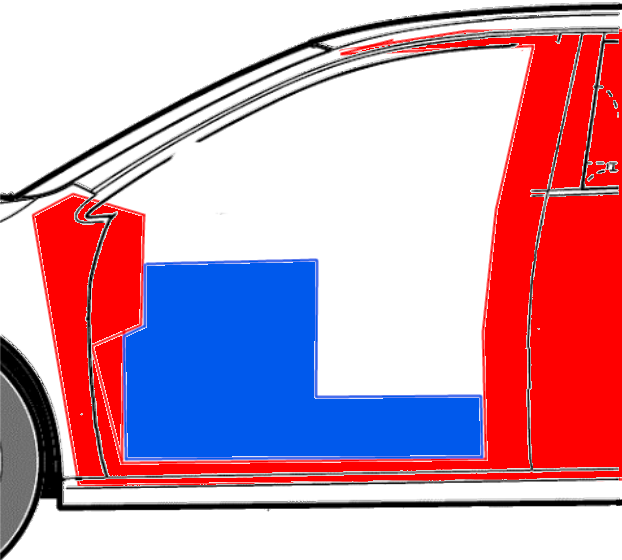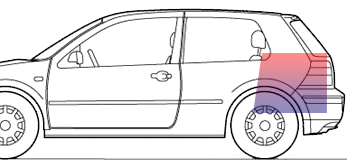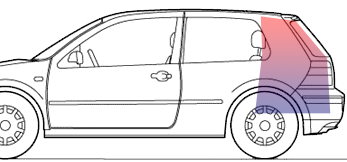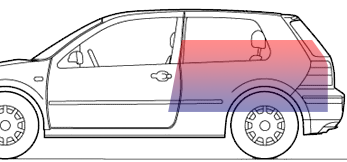This SPL format is very easy going. The rules are as accommodating as possible so that it allows people to get LOUDER with their chosen installs or categories.
New SANTA POD venue rules --> CLICK HERE
RULES
SPL TESTING
Propper Droppers is totally different to any other SPL format.
- All the SPL measurements are taken from the inside of the car with the SPL sensor positioned on the drivers or passenger’s headrests.
- In order to get as accurate and common testing position within all vehicles, where possible, the head rests / seats are moved forwards or backwards to mimic a drivers normal driving position. This position will be at the discretion of the judges for a fair and even playing field for all.
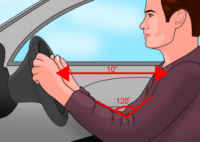
- The box build must be no more than 5 inches in front of the B-pillar, and must not affect a drivers normal driving position.
- The SPL Sensor is always facing towards the front windscreen.
This way you get a good idea of the SPL levels that your ears are subjected too as well.
A series of tests are carried out to see how well the system performs at playing certain low bass frequencies as loud as possible.
The test consists of playing 4 set Test Tones.
- 40Hz - 33Hz -25Hz - 20Hz. This shows you how well your system performs at playing low bass.
- The loudest of these 4 set frequencies will be regarded as your PEAK SPL.
- After the test has been carried out the peak score and set scores are added together and then divided by 5. This works out your average score.
It’s the average score that determines the systems position in the (((pd))) SPL Leagues.
SPL LEAGUES
Your position in the SPL leagues is worked out as follows:
Example:
40Hz = 150.4dB
33Hz = 152.7dB
25Hz = 151.6dB
20Hz = 150.7dB, Peak = 152.7dB @ 33Hz
All these scores are added together & then divided by "five" - Five being the number of different scores that have been achieved. By doing this we get the TOTAL AVERAGE score achieved during the SPL testing session. Which in this case would be 151.6dB
SPL MEASURING EQUIPMENT
(((pd))) uses an industry standard SPL sensor as used by the world’s most popular SPL organisations. Known as the TermLab Sensor - It is currently the most accurate & reliable way of testing for SPL.
SPL READINGS
Must be taken using a TermLab sensor. The Sensor must also be placed in the same position for each car.
SPL SENSOR POSITION
We are attempting to get an SPL reading which is as reasonably accurate as possible, as if you were listening to it. To that end we take the SPL readings from roughly where your head would be when sitting in the vehicle.
The SPL sensor has to be positioned on a head rest or wedged between the bottom of the head rest and top of the seat and must be facing towards the front windscreen.
The seat position ideally, should be in a drivers normal driving position. This position will be at the discretion of the judges for a fair and even playing field for all.
GENERAL RULES
- Hearing Protection is provided & is advised to be worn during the SPL testing process.
- Disclaimer for damage against equipment & personal injury due to exposure of high SPL levels should be signed before any test is to be carried out.
- Engines can be left running / idling - The accelerator is allowed to be pressed if the participant feels that this may help to increase his / her score, whilst playing a test tone.
- All SPL categories can have as much bass amps that will fit into the available space of the category that their system falls into.
- Batteries can be positioned anywhere throughout the vehicle - Amplifiers that are not used for powering subwoofers can also be positioned anywhere throughout the vehicle.
- All categories can have as much sound deadening / strengthening mods as reasonably required bearing in mind the floor pan and roof limits.
- No restrictions on any type of playback equipment - Cd Players, DVD Players, I-POD, USB, SD, Blue Tooth - Hard Drives etc. can all be used.
- There is an advised 30sec time limit for each frequency attempt.
- The testing is normally carried out by using an officially available test CD or a digital form of test CD.
- However, if the participant feels that their system can play certain frequencies louder by actually playing music instead of the test tones that are provided on a Test CD etc. then they are free to try using that method.
- The use of external battery supplies and power sources which are outside the vehicle are currently prohibited.
- Battery trays are allowed however they must be positioned within the inside of the vehicle - The only exception is Rule 9.2.
- Build downs to stored batteries from below the floor pan are allowed provided the tray has been constructed in a safe manner and also completely seals the batteries from the outside of the vehicle - rendering the battery tray as part of the internal structure of the vehicle.
- More than one person can be inside the vehicle whilst testing, this includes filling every seat in the car with strangers if you think that may improve your score! Adding people reduces the volume of air in the car, but also disrupts the flow, so it can either help or hinder. The number of people you use must be decided before testing starts.
- The SPL sensor can be placed on either the passenger or drivers head rests.
- The SPL sensor, once positioned on passengers or drivers head rest must remain in that position throughout the SPL testing process.
- You cannot swap the positions mid testing but you can re-test with the sensor on a different side afterwards
- The higher scores can be taken as the participants systems score. This benefits system that are built for other SPL formats as the port is usually to one side of the vehicle.
- Re-tests are only allowed if time permits at the end of the event.
- The use of boards or any kind of material to reflect or direct sound pressure towards the sensor is prohibited.
- The person who has signed into the competition must be the person controlling the system through the lanes. We will allow exceptions for first timers that need help.
EXTRA STUFF
FRONT SEATS
- Walled vehicles must have their wall build behind both front seats.
- The drivers seat must be in a practical / comfortable driving position.
- Both Front seats are to be aligned with each other so that the passenger seat mirrors the position of the drivers seat.
DOORS / WINDOWS / BODY PANELS
- Any combination of doors, windows or sunroofs, even the boot, can be opened or closed to try & and achieve a higher SPL score.
- Doors, windows, sunroofs, roofs and body panels etc. can be pushed against to try & achieve a higher score.
STRIPPER POLES / BRACING
- The use of props / bracing or what has become affectionately known as stripper poles can be used anywhere inside the vehicle.
- Stripper poles or any type of bracing that connects the bass enclosure to the roof of the vehicle are prohibited. If any system uses poles or bracing in this manner, then they will be put into the next suitable category.
- For standard Boot Boomers (BB) this means the system will be put into Boot Boomers extreme (BBX).
- No Wall systems doing this will be put into a Walled Category.
VANS
Vans with bass boxes in rear / or rear walled installs that are at the far back of the vehicle.
In the past (((pd))) has tried to accommodate small van systems.
Those people who had a van with lets say a speaker box in the back, where if it was a normal car, would be in the boot area. ...We would have tried to put their system into the nearest suitable boot class.
This has become increasingly harder and has now reached a point where it is impossible to clarify a set area or distance limit without cause of controversy amongst competitors and SPL Judges.
- Any Van with a system that looks like it would be in the boot area of a normal car will now be put into NO WALL Category.
- The same NO WALL rules applies to vans with systems that fall into this criteria.
- Any Van with any type of Walled build will be put into their respective Walled 6k / Walled+ or Walled Extreme Category
PORT BLOCKING - MULTIPLE USE PORTS
The standard SPL test does not allow for any kind of port or box alterations in which to increase specific frequencies.
The idea of this test is to see just how well your current set up performs at playing low bass.
If a port blocker is used, then the scores achieved during the SPL test with that set up will be used if it happens to be a louder average than the previous system.
BUILD LIMITS
- You are allowed to build a Wall or have the No Wall Box extend into the cabin area by up to 5" in front of the B-Pillar as long as is does not affect a drivers normal driving position.
- Traditionally mounted subwoofers can be fixed as normal, to the front of the enclosure.
- Reverse mounted subs cannot exceed the B-Pillar Front build Limit.
- The port cannot Exceed the B-Pillar front build limit.
- The port itself cannot be purposely directed towards the sensor.
Floor Pan:
- Any type of material apart from sound deadening sheets that is fitted / bonded to the floor pan of the vehicle will render the build an Extreme Build.
- A thickness of up to 10mm of sound deadening sheets or for example 4x layers of Anti VIbe mat(2.5mm thick) are allowed on the floor pan. Anything over this will render the system an Extreme build.
Roof Builds:
- Roofs / Any combination of sound deadening sheets and other sheet materials that are thicker than 100mm or lower than the door openings will render the build an Extreme Build
ISO SYSTEMS
This is where two subs are mounted in such a way as to provide extra motor strength but still using the same cone area as a normal subwoofer.
Clam shell method is the most popular method of mounting in this way.
Any system which participates using this type of set up will have each clamshelled pair of subwoofers classed as one subwoofer because you are still using the equivalent cone area of one subwoofer per ISO pair.
EXTRA PANELS / WINDOW COVER BOARDS
- The use of panels / boards or any kind of internal baffles are prohibited to be used on windows anywhere in front of the B-Pillar - regardless of category.
- No panels or boards are allowed to be fitted to any window that is in front of the B pillar.
- Boot Boomers - People covering their windows in the boot behind the rear seats with panels in standard Boot Boomer categories will have the system put into BBX, Boot Boomers Extreme.
- If any windows in front of the rear seats are panelled, this puts your system into NO WALL category.
- NO WALL - Only the side windows may be boarded.
- To ensure that none of the panels are connected to each other or to the box or the roof of the vehicle. There must be a clearly visible 10mm minimum gap around each panel so that the frame of the vehicle can be seen. This allows the judge to check that the panels are in no way attached to any adjacent panel or to the bass enclosure.
SUBWOOFERS SMALLER THAN 10"
Subwoofers in this SPL format start from a 10"
Any subwoofer that is smaller than a 10" will be counted as a 10"
If a Boot Boomer competitor enters the competition using 6" or smaller subwoofers, then they will be put into the closest category based on their maximum nearest number of subwoofers used.
A system using 1 x 6" sub will be put into BB1, a system using 2 x 6" subs will be put into BB2, a system using 3 x 6" subs will be put into BB4 as the amount of subwoofers used is more than BB2
PASSIVE RADIATORS
Passive radiators will be regarded as ports unless it cannot be determined that they are passive. This will be up to the judges discretion.
VOLTAGES
(((pd))) is implementing a voltage limit to all systems - This is now 20 volts.
CATEGORIES
BOOT BOOMERS
Currently split into 5 groups
-
BB1 - Boot Boomers 1:
1x 8" / 1x 10"
-
BB2 - Boot Boomers 2:
2x 8" / 2x 10" / 1x 12"
-
BB4 - Boot Boomers 4:
4x 8" / 4x 10" / 2x 12" / 1x15"
-
BB6 - Boot Boomers 6:
6x 8" / 6x 10" / 4x 12" / 2x 15" / 1x 18"
Boot Boomers Limits:
- The system must be within the boot area of the car as in, it has to be in the boot area behind the rear seats when they are in their factory position.
- Boot Boomers height limit is 2" above the top most level of the rear seats. This does not include the headrests.
- Any part of the box or bass system which exceeds this limit will be put into BOOT BOOMERS EXTREME
This includes:
- Any part of the subwoofers including the surround.
- Ports
- Scooped canopies
- Bass Amplifiers
- Other amps or speakers are allowed past this level, as long as they are not part of the equipment used to reproduce bass frequencies.
-
BBX - Boot Boomers Extreme
Anything that exceeds BB6 or the standard BB height limit of 2" above top of rear seats
This category is for any boot system that does not fall into the rules above. It allows for any type of boot system as long as it is behind the rear most seats.
Full walled boots are allowed - boxes that go right up to the roof are allowed, anything really.
NO-WALL
No-Walled systems that are a lot larger than normal and usually take up both the rear seat areas and boot areas of the vehicle.
NO WALL Limits:
- The box or subwoofer enclosure itself must not be higher than the centre point of the side windows. Any system that has a subwoofer enclosure that is above this level will be put into WALLED category.
- The systems amps and subs when mounted mags out, can extend beyond the height limit in this category.
- Any type of internal build, battery trays and vehicle modification are allowed in this class except external power supplies.
- You are NOT ALLOWED to build a baffle @ the B-Pillars to seal off the area above the box as this has the effect of walling off the front cabin area.
- Pick up trucks with Blow-Throughs, although having their systems within the NO-Wall height limit will also be regarded as a walled system because the cabin area is completely walled off.
WALLED 6K
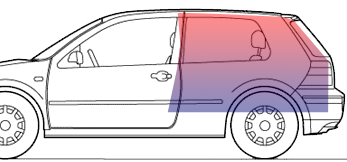
- The rear of the car is normally filled with a huge wall of subwoofers which fill up the whole vehicle starting from just behind the front seats, filling the space from top to bottom of the vehicle and also extending into the boot area.
- Any type of internal build, battery trays and vehicle modification are allowed in this class except external power supplies.
- Bass amp power up to 6k of manufacturers specification at 1ohm / 14.4v.
WALLED +
Walled+ is simply any walled system with over 6k of manufacturers recommended amp power at 1ohm / 14.4v.
EXTREME
These rules have been added to keep things fair, and to continue our spectator values. Fair, but still fun, and still being able to jam a couple of people inside brave enough for demos!
The Car must be driveable into and out of the lanes.
Seats
- Any modifications of the seats themselves in which parts have been altered / cut down or removed or added too.
- Moved or re-fixed the seats or runners in such a way as to allow more or less movement than the original factory fitted equipment had originally provided.
- Removed seats or the fitment of solid seats etc.
Glass
- Windscreens can have a center brace up to 4 inches wide
- Windscreen must not be covered more than 3 inches from the edges for strengthening.
- Windscreen and side windows can be perspex but must be transparent.
- Door window frames can be covered up to 3 inches into the window area for strengthening of the window frame. This includes the inner doorway opening.
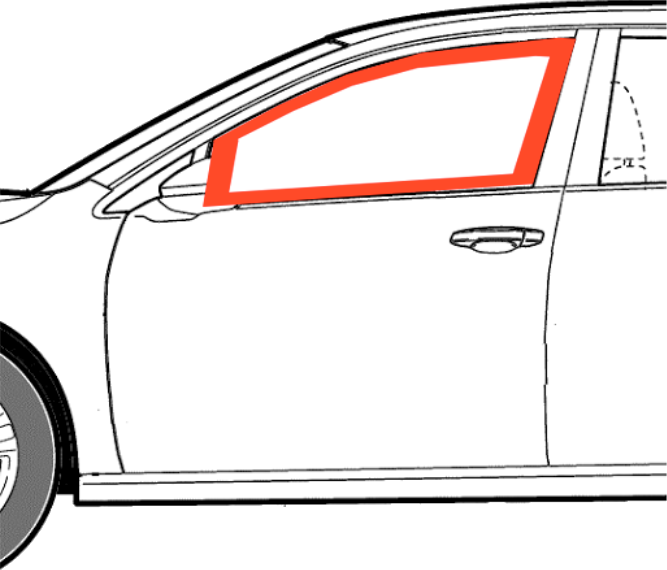
Internal build
- Sub enclosure cannot be more that 5 inches in front of the B piller AND must not affect a drivers normal driving position..

- Doors with speaker builds must not be thicker that 10 inches past the original doors steel.
- Flat door builds must be no more than 5 inches past the original doors steel.
- Dashboards can be rebuilt, but must be roughly similar in size to the original and must not be an obvious attempt to reduce cabin area.
Center console
- Center consoles cannot be higher than the center point between the built floor and the roof, and no longer than half the length of the gap between the dash and the enclosure.
- They can stretch the whole length up to 10 inches from the built floor (see the blue area below).
- Center consoles rebuilds cannot be more than 12 inches in width, from the dashboard and back.
Floor
- The floor in front of both seats (or where the front seats were!) must not be more than 5 inches thicker than the original floor level
- Footwells can be boarded off but must not extend from the dashboard.
